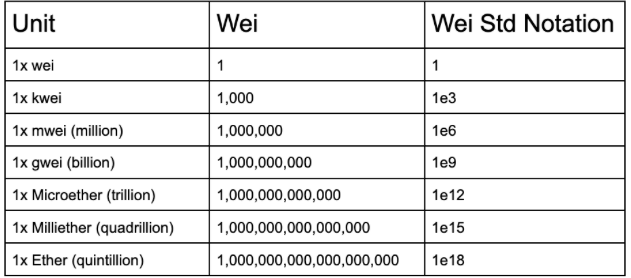Have you heard the term “gas” in relation to the Ethereum Virtual Machine? Are you scratching your head, wondering how someone could possibly need gasoline so they can pay $30,000 for a jpeg of a drooling gorilla?
What Is Gwei?
Gwei is a denomination of a popular cryptocurrency known as Ether or Ethereum. It is the fuel used to power transactions on the Ethereum blockchain and provide the gas that keeps the network running.
You’re in the right place. This article will break down some of the basics of gwei and gas and how they relate to the Ethereum ecosystem.
What Is Gwei?
Gwei is simply a denomination of a popular cryptocurrency known as Ether or Ethereum. It is not the only denomination; if you look at the table below, you will see that kwei, mwei and gwei are featured in rapid succession. Following the prefix designations used within the metric system, each of these unit denominations is a portmanteau of the prefix. In the case of gwei this would be “giga” or billion, and “wei.” In short, 1 gwei = 0.000000001 ETH.
The easiest way to conceptualize gwei is with a simple chart.

Most informed consumers will not be satisfied merely understanding that one gwei is equivalent to one-billionth of a unit of Ether. Curious folk will want to understand what that truly means. Fortunately for these individuals, we can break this concept down even further with an example.
What Is Gwei? An Example
Picture a table with two individuals seated across from each other. Benjamin is holding a crisp $100 bill and Abraham is holding a shiny penny. What is the difference between the currency Ben and Abe are holding? Ben is holding a paper-like fabric with various distinctive markings on both sides. Abe is holding a small metal disk made of zinc coated in copper.
The currency Ben is holding could be used to purchase a reasonably full cart of practical groceries. The currency Abe is holding is worth less than the scrap metal value of the material it is printed on. The difference between a unit of Ether and a unit of gwei is more than twice the difference between the orders of magnitude between $100.00 and $0.01.
The term “orders of magnitude” typically refers to the smallest possible power of 10 that can be used to represent a number in relation to a standard reference point. Consider $1USD to be the standard in this example. The $100 note is 2 orders of magnitude larger than a single dollar. Conversely, the penny is 2 orders of magnitude smaller than a single dollar.
Now imagine two denominations of a currency with a difference of 9 orders of magnitude. Like many other cryptocurrencies, and in contrast to more traditional fiat currency, Ether is not restricted to the bounds of physical objects like fabric or metal.
Instead, the currency is built on a platform that allows for 18 decimal places for the division of Ether. Building on our earlier U.S. dollar comparisons, the dollar has 2 decimal places for the division of dollars. You can’t cut a penny into pieces. It’s both illegal and an ineffective strategy for further dividing the store of value.
Verbiage gets a bit tricky here. The Ethereum Foundation, Ethereum Network and an expansive community of Ethereum developers created the Ethereum Virtual Machine, a distributed, trustless computer capable of processing smart contracts. This system raised an early round of funding through the initial coin offering of Ethereum.
What Is Gwei Used For?
With the current ETH / USD exchange rates, gwei is used to quantify the fees involved in processing on-chain transactions. With time this will likely change. The price of Ether could crater, and gas fees may then be calculated in Microether or Milliether; but for the foreseeable future it’s safe to assume gwei will be the best denomination for quantifying transaction fees.
Transactions can be a simple transfer of value between two accounts, but the Ethereum Virtual Machine is also capable of processing complex logical operations carried out by smart contracts. In our next example, let us assume the former for the sake of simplicity. You bought 2 Ether from an exchange. You navigate to the withdrawal/send functionality, and transfer half your purchase to your friend Stanley and the other half to another friend, Albert. One might assume Stanley and Albert each have 1 Ether, right?
Ethereum transactions need gas fees to support the expense of operating the network.
In a practical sense, yes, but technically no: for the sake of simplicity we will say they each received 0.99 Eth. What happened to that hundredth of an Ether? It was used to pay for the gas fees necessary to execute the transaction. In centralized systems this is meaningless. Transferring money from a checking account to a savings account with the same bank is a poor parallel for what’s happening in a blockchain based system of accounts.
In short, Ethereum transactions need gas fees to support the expense of operating the network.





